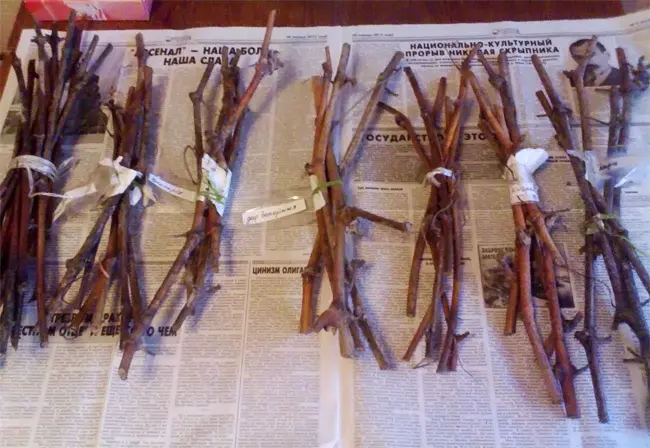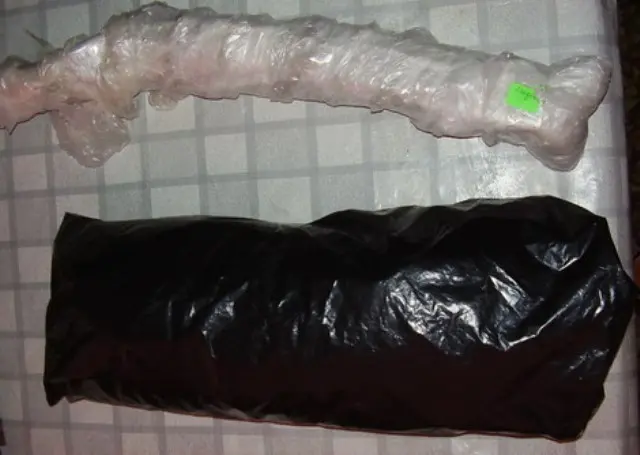Contents
In order to propagate your favorite grape variety, you need to spend only a minimum of effort and in a year the harvest can double. But for this to happen, and the stalk to successfully take root, it is necessary to strictly and strictly follow certain rules. They relate to how to properly prepare and how to save grape cuttings in winter, because, as you know, cuttings need to be harvested in the fall.
What should be cuttings for storage
In order for the cuttings, or, as they are also called, chibouks of grapes to survive the winter and survive until spring, they must be properly prepared.
In viticulture, only vegetative propagation is used by means of cuttings or seedlings, excluding sowing seeds. It so happened due to the fact that the seed method is used only in breeding to create new varieties, but it is not suitable for reproduction (the properties of the variety are not saved in this case).
It is necessary to start harvesting grape cuttings in the fall (in the second half of October, sometimes in early December), immediately after leaf fall. If your area is characterized by frosts that occur immediately after leaf fall, then the cuttings are prepared even earlier.
The ideal time for preparing grape cuttings is the time after the first frost and before the ambient temperature drops below -10 degrees.
This choice of time is due to the fact that by this period the vine has accumulated the maximum amount of nutrients and has passed the first cold hardening. Therefore, such chibouks will be of the highest quality after they are removed from the wintering place.
Pruning of the grape bush is carried out in order to prepare cuttings that will be stored all winter.
Grape cuttings intended for spring planting must meet the following requirements:
- the grape vine that is cut must be ripe for that year;
- the vine should be healthy and have a uniform brown color (no spots) and crack slightly when bent;
- the core of the vine should not be loose;
- the cuttings are not cut in the middle of the internode, but recede two or three centimeters higher above the node (there is enough space left for a possible future grafting);
- vines should not be mechanically damaged;
- there is evidence that crooked cuttings take root and grow poorly. Therefore, it is desirable that the vine be more straight;
- we cut the cuttings in such a way that four well-developed buds remain on them;
- the diameter of the cuttings for storage must be at least 5 mm;
- it is best to cut the middle part of the vine;
- the length of the chibouks must be at least 50 cm and not longer than 70 cm (although you can find information that their length is allowed up to 140 cm);
- not fallen leaves and tendrils are removed.
All manipulations for the preparation of cuttings should be carried out with clean and well-sharpened garden tools: secateurs and knives.
It is impossible to harvest grape cuttings for storage in winter from barren bushes and fattening thick shoots, the diameter of which is more than 12 mm.
As mentioned above, the length of cuttings for storage can be different: from 50 cm to 140 cm. It is believed that a length of 50 cm will allow you to get more powerful annual seedlings, but a length of 140 cm will provide better survival in winter.
After the cuttings are already cut, they begin to prepare them for storage in the winter. To do this, all leaves, antennae are removed from them, they are cleaned of stepchildren.
Then, after the preparations described above, all cuttings of the same variety must be collected in a bundle and tied. Do not forget to put a label on the bundle with the following information: grape variety, date of harvest, place of future planting (if known). The inscriptions on the label are best done with a pencil, since the inscription made with a ballpoint pen or any other pen can fade.

Ways to store cuttings
In order for grape cuttings to be stored all winter, you need to follow some rules. There is a lot of information about how to store grape cuttings in winter. Let’s look into it in more detail.
An important indicator for the storage of chibouks is their water content. Since the cut, the water content has been steadily decreasing. A decrease in this indicator by more than 20% can ruin the cutting, and it will be unsuitable for planting and future growth (even a long stay in the water in the spring will not help). Do not carry out additional soaking of chibouks before sending them to storage. Minor soaking from a couple of hours to several days is allowed, but not before being placed in storage.
It is impossible to soak for more than two days, otherwise the kidneys may “suffocate”. Water should be used only clean and fresh (spring water is perfect).
Further, the chibouks must be protected from possible pests and fungal diseases. To do this, they are treated (sprayed or dipped) with a 3% solution of copper or iron sulfate. Then they are placed in a plastic bag (only the bottom of the handle, and its top should protrude).
After the chibouks of grapes have been harvested and collected in bunches, you can leave them for storage. Remember that the temperature in the storage must be low in order to reduce the intensity of the processes occurring in the chibouk. Under such conditions, there will be minimal loss of carbohydrates. But do not forget that the temperature must be at least 0 ° C, otherwise the cuttings will dry out.
Thus, the optimal temperature range in storage will be above 0°C (approximately +0,4°C) and not above +8°C. If the temperature is higher, then swelling of the kidneys and their blooming is possible. Also an important indicator is the humidity of the room.
Based on these requests, cuttings can be stored in the following places:
- cellar;
- refrigerator;
- trench.

Storage of chibouks in the basement or cellar
With this option, grape cuttings must be placed in polypropylene or plastic bags and placed in the basement. Once a month they need to be checked to keep them in good condition until spring.
If the chibouks are dry, then they are moistened, and if they are moldy, air with a rag that has been moistened with a 3% solution of copper or iron sulfate (calculated as 1 teaspoon per one glass of water).
The most ideal is the storage of cuttings of grapes in the cellar. To do this, they are placed in sand or in bags with moistened coniferous sawdust. The latter option, due to the carbon dioxide accumulated in the bags, will lead to the conservation of pathogenic microflora and at the same time reduce the consumption of carbohydrates by cuttings. The only thing you should pay attention to is the moisture content of sawdust or sand. They should not be allowed to over-moisturize.
Storing chibouks in the refrigerator
In the absence of the possibility of storing grape cuttings in the basement or cellar, an ordinary household refrigerator will come in handy.
This method is suitable provided that the number of cuttings is not too large, and their length is about 50 cm. In the middle part of the refrigerator, it is necessary to place the shelves so that the distance between them is at least 10 cm. As a result, a niche is formed.
With this storage option, the cut vines are wrapped not in a plastic bag, but in a thin cloth or gauze. They must be moistened with a solution of vitriol (3%). And only then, this bundle can be put in a plastic bag and placed in the refrigerator.
The cuttings should be checked once a month and, if necessary, moistened and wiped with a solution of vitriol.
Experienced gardeners recommend putting a thermometer in it for a couple of hours before placing the bundle in the refrigerator to make sure that the required temperature is available.
Storing chibouks in a trench
For this storage option, you need to choose a secluded place and dig a trench there. Its depth should be one spade bayonet. In this place, water should not stagnate.
After the trench has been dug, we place the chibouks inside and fill it with earth. In this situation, they cannot be packed in polyethylene, otherwise they may rot.
The above options for storing cut grape vines in winter are the most common, since they provide maximum survival of chibouks (provided, of course, that they are harvested correctly).
You can find information that grape cuttings, like cuttings of fruit trees (such as pears and apple trees), are allowed to be stored in winter, simply tied to the vine, as to tree branches. But, this method is absolutely not suitable for storing grapes. The cuttings in this case will be of little use for planting.
Video “Rules for storing grape cuttings”
This video contains detailed information regarding the nuances of storing chibouks.
When choosing a place to store chibouks, one must proceed not only from the available information, but also from your capabilities. It is also advisable to consult with knowledgeable people who have been engaged in self-harvesting of cuttings for several years, and will be able to advise you not only on the most optimal storage option, but also give a lot of useful advice.









